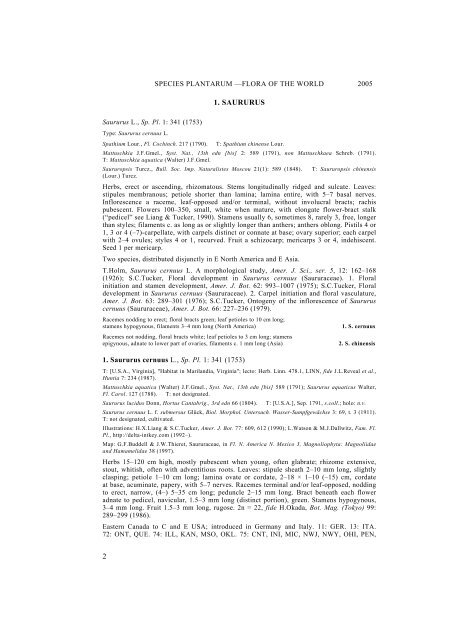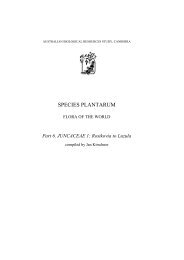Saururaceae - Species Plantarum Programme
Saururaceae - Species Plantarum Programme
Saururaceae - Species Plantarum Programme
You also want an ePaper? Increase the reach of your titles
YUMPU automatically turns print PDFs into web optimized ePapers that Google loves.
SPECIES PLANTARUM —FLORA OF THE WORLD 2005<br />
1. SAURURUS<br />
Saururus L., Sp. Pl. 1: 341 (1753)<br />
Type: Saururus cernuus L.<br />
Spathium Lour., Fl. Cochinch. 217 (1790). T: Spathium chinense Lour.<br />
Mattuschkia J.F.Gmel., Syst. Nat., 13th edn [bis] 2: 589 (1791), non Mattuschkaea Schreb. (1791).<br />
T: Mattuschkia aquatica (Walter) J.F.Gmel.<br />
Saururopsis Turcz., Bull. Soc. Imp. Naturalistes Moscou 21(1): 589 (1848). T: Saururopsis chinensis<br />
(Lour.) Turcz.<br />
Herbs, erect or ascending, rhizomatous. Stems longitudinally ridged and sulcate. Leaves:<br />
stipules membranous; petiole shorter than lamina; lamina entire, with 5–7 basal nerves.<br />
Inflorescence a raceme, leaf-opposed and/or terminal, without involucral bracts; rachis<br />
pubescent. Flowers 100–350, small, white when mature, with elongate flower-bract stalk<br />
(“pedicel” see Liang & Tucker, 1990). Stamens usually 6, sometimes 8, rarely 3, free, longer<br />
than styles; filaments c. as long as or slightly longer than anthers; anthers oblong. Pistils 4 or<br />
1, 3 or 4 (–7)-carpellate, with carpels distinct or connate at base; ovary superior; each carpel<br />
with 2–4 ovules; styles 4 or 1, recurved. Fruit a schizocarp; mericarps 3 or 4, indehiscent.<br />
Seed 1 per mericarp.<br />
Two species, distributed disjunctly in E North America and E Asia.<br />
T.Holm, Saururus cernuus L. A morphological study, Amer. J. Sci., ser. 5, 12: 162–168<br />
(1926); S.C.Tucker, Floral development in Saururus cernuus (<strong>Saururaceae</strong>). 1. Floral<br />
initiation and stamen development, Amer. J. Bot. 62: 993–1007 (1975); S.C.Tucker, Floral<br />
development in Saururus cernuus (<strong>Saururaceae</strong>). 2. Carpel initiation and floral vasculature,<br />
Amer. J. Bot. 63: 289–301 (1976); S.C.Tucker, Ontogeny of the inflorescence of Saururus<br />
cernuus (<strong>Saururaceae</strong>), Amer. J. Bot. 66: 227–236 (1979).<br />
Racemes nodding to erect; floral bracts green; leaf petioles to 10 cm long;<br />
stamens hypogynous, filaments 3–4 mm long (North America)<br />
Racemes not nodding, floral bracts white; leaf petioles to 3 cm long; stamens<br />
epigynous, adnate to lower part of ovaries, filaments c. 1 mm long (Asia)<br />
1. Saururus cernuus L., Sp. Pl. 1: 341 (1753)<br />
1. S. cernuus<br />
2. S. chinensis<br />
T: [U.S.A., Virginia], "Habitat in Marilandia, Virginia"; lecto: Herb. Linn. 478.1, LINN, fide J.L.Reveal et al.,<br />
Huntia 7: 234 (1987).<br />
Mattuschkia aquatica (Walter) J.F.Gmel., Syst. Nat., 13th edn [bis] 589 (1791); Saururus aquaticus Walter,<br />
Fl. Carol. 127 (1788). T: not designated.<br />
Saururus lucidus Donn, Hortus Cantabrig., 3rd edn 66 (1804). T: [U.S.A.], Sep. 1791, s.coll.; holo: n.v.<br />
Saururus cernuus L. f. submersus Glück, Biol. Morphol. Untersuch. Wasser-Sumpfgewächse 3: 69, t. 3 (1911).<br />
T: not designated, cultivated.<br />
Illustrations: H.X.Liang & S.C.Tucker, Amer. J. Bot. 77: 609, 612 (1990); L.Watson & M.J.Dallwitz, Fam. Fl.<br />
Pl., http://delta-intkey.com (1992–).<br />
Map: G.F.Buddell & J.W.Thieret, <strong>Saururaceae</strong>, in Fl. N. America N. Mexico 3, Magnoliophyta: Magnoliidae<br />
and Hamamelidae 38 (1997).<br />
Herbs 15–120 cm high, mostly pubescent when young, often glabrate; rhizome extensive,<br />
stout, whitish, often with adventitious roots. Leaves: stipule sheath 2–10 mm long, slightly<br />
clasping; petiole 1–10 cm long; lamina ovate or cordate, 2–18 × 1–10 (–15) cm, cordate<br />
at base, acuminate, papery, with 5–7 nerves. Racemes terminal and/or leaf-opposed, nodding<br />
to erect, narrow, (4–) 5–35 cm long; peduncle 2–15 mm long. Bract beneath each flower<br />
adnate to pedicel, navicular, 1.5–3 mm long (distinct portion), green. Stamens hypogynous,<br />
3–4 mm long. Fruit 1.5–3 mm long, rugose. 2n = 22, fide H.Okada, Bot. Mag. (Tokyo) 99:<br />
289–299 (1986).<br />
Eastern Canada to C and E USA; introduced in Germany and Italy. 11: GER. 13: ITA.<br />
72: ONT, QUE. 74: ILL, KAN, MSO, OKL. 75: CNT, INI, MIC, NWJ, NWY, OHI, PEN,<br />
2












